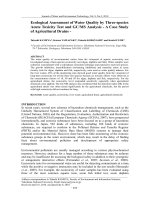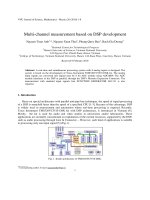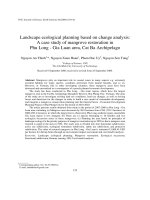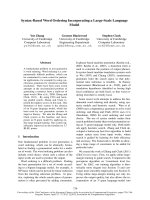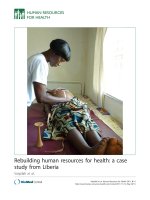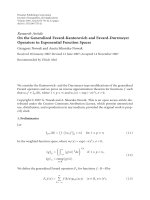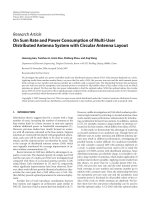Báo cáo " Landscape ecological planning based on change analysis: A case study of mangrove restoration in Phu Long - Gia Luan area, Cat Ba Archipelago" pot
Bạn đang xem bản rút gọn của tài liệu. Xem và tải ngay bản đầy đủ của tài liệu tại đây (879.44 KB, 12 trang )
VNUJournalofScience,EarthSciences24(2008)133‐144
133
Landscape ecological planning based on change analysis:
A case study of mangrove restoration in
Phu Long - Gia Luan area, Cat Ba Archipelago
Nguyen An Thinh
1,
*, Nguyen Xuan Huan
1
, Pham Duc Uy
2
, Nguyen Son Tung
1
1
College of Science, VNU
2
Ho Chi Minh City University of Technology
Received 9 September 2008; received in revised form 25 September 2008.
Abstract. Mangroves play an important role in coastal zones in many aspects e.g. extremely
essential habitats for many species, coastlines protection from natural hazards, and so on.
However, in Vietnam, like in other developing countries, these mangrove areas have been
destroyed and encroached as a consequence of a poorly planned economic development.
The study has been conducted in Phu Long - Gia Luan region, which have the largest
mangrove area in the Cat Ba Archipelago Biosphere Reserve, Hai Phong City, Vietnam. The aims
of the study are to investigate existing land use conditions, land use changes, as well as driving
forces and directions for the changes in order to build a case model of sustainable development;
and integrate a mangrove conservation planning into the General Socio - Economic Development
Planning Project of Hai Phong City for the period of 2010-2020.
The article presents results obtained from study in the period of 2007-2008 in Phu Long - Gia
Luan area, including (a) Mangrove area decreased by 98.9 hectares from 1994 (792.3 hectares) to
2006 (693.4 hectares), in which the largest lost is observed in Phu Long southern region, meanwhile
Gia Luan region is less changed; (b) There are 12 species belonging to 10 families and two
ecological succession series in these mangroves; (c) Planning the area based on principles of
landscape ecology for the priority purposes of mangrove restoration up to 2020 so that a mangrove area
restored is equal to the area in 1994. The study area is divided into four functional subdivisions:
active use subdivision, ecological restoration subdivision, stable use subdivision, and protective
subdivision. The value of restored mangrove in Phu Long - Gia Luan is estimated 15,908.45 USD
per hectare for shrimp farms through an environment impact assessment and cost-benefit analysis.
Keywords: Landscape ecological planning; Mangrove restoration; Ecological succession;
Functional subdivision; Remote sensing; GIS; Cost-benefit analysis.
_______
*
Corresponding author. Tel.: 84-912300314.
E-mail:
N.A.Thinhetal./VNUJournalofScience,EarthSciences24(2008)133‐144
134
1. Introduction
Mangroves are ecologically important
coastal ecosystems, currently cover 146,530 km
of the tropical shorelines of the world. This
represents a decline from 198,000 km of
mangroves in 1980, and 157,630 km in 1990.
These losses represent about 2% per year
between 1980 and 1990, and 1% per year
between 1990 and 2000 [6]. Vietnam has
favorable conditions for mangrove
development, such as estuaries and inlets long
coastline of approximately 3260 km in length,
large river systems rich in alluvia and tropical
and monsoon climate. However, many
mangrove areas have been destroyed to practice
aquaculture, especially shrimp rearing over the
last years [10]. The consequence is that both
ecological services which are provided for local
people by these ecosystems and ecological
functions are adversely impacted.
The selected study area is the Phu Long -
Gia Luan tract belonging to the Cam - Bach
Dang estuary, Hai Phong City, which is a
northern province of Vietnam (Fig. 1). This
area has the largest mangrove area in Cat Ba
Archipelago Biosphere Reserve. Hence, it was
chosen as a case model of sustainable
development. Mangrove reservation planning
was integrated into the General Socio -
Economic Development Planning Project of
Hai Phong City for the period of 2010-2020.
This problem arises from that along with the
development of aquaculture, shrimp farms have
been enlarged and as a consequence, mangrove
areas have been destroyed, especially from the
beginning of Doi Moi period (1986) up to now.
That is a challenge of sustainable development
in this area.
Restoration of areas of damaged or
destroyed mangroves has been previously
discussed. The discussions were about using of
system dynamics modeling in design of an
environmental restoration banking institution
[1], functionality of restored mangroves [2],
rehabilitation of mangrove ecosystems [3],
ecological engineering for successful
management and restoration of mangroves [6],
analysis of factors influencing community
participation in mangroves restoration [8]. In
Phu Long - Gia Luan region in particular, some
studies have been conducted, such as studying
structure, distribution and succession on
mangrove ecosystems in Phu Long area [4];
research on managing the coastal area resources
and estimating environmental economic values
for mangrove areas [9]. However, there still is a
few of studies in this area conducted based on
the landscape ecological fundamentals in
general. Remarkably, mechanism of primary
and secondary ecological succession of
mangroves was showed but it is for the
Northern - East coastal regional scale and not
specific for the selected area [4]. Therefore, this
article deals with the supports of remote sensing
technology integrated in landscape ecological
fundamentals to study specifically on restoring
mangrove ecosystems in Phu Long - Gia Luan
area.
Fig. 1. The selected area in Cat Ba Archipelago
2. Research methods and applied principles
of mangrove restoration
2.1. Research methods
The selected research methods for this study
are the followings:
- Field survey methods: Investigating 20
quadrates with 10mx10m size per one. The
N.A.Thinhetal./VNUJournalofScience,EarthSciences24(2008)133‐144
135
TOA rapid water quality assessment machine
was used to analyze 43 water samples for 6
criteria (dissolved oxygen, salinity, pH,
conductivity, turbidity, temperature).
- Social investigation method: In March
2008, we conducted 30 household surveys to
obtain information on aquaculture development
patterns and mangrove management practices.
Additionally, we conducted interviews with
regional planners in Hai Phong, Cat Ba
Archipelago Biosphere Reserve officials, and
leaders of Phu Long, Gia Luan communes at
multiple administrative levels.
- Remote sensing and GIS method: Main
data used are topographical map 1:25,000
(edited in 2006) and satellite images (SPOT3 in
1994 and SPOT5 in 2006). All satellite images
were rectified, geo-referenced and processed by
using ENVI (the Environment for Visualizing
Images) software version 4.1 and then these
images were interpreted manually based on the
platform. These satellite images are rectified by
Nearest Neighbor Method (Select GSPs: Image
to Map) and classified by Supervised
Classification allowing to classify the images
based on sample pixels which are identified by
analyzers. Finally, the satellite images are used
for mapping existing mangroves in 1994 and
2006 years and mangrove changes in this period
by using ArcGIS 9.1 software (Fig. 1).
Spot satellite images (1994 and
2006)
Rectified
Classified with validation
GIS works
Verifying, evaluating accuracy
1994 mangrove forest map
2006 mangrove forest map
Mangrove forest change map
in the period of 1994-2006
- Covariance
- Ground trusting
Fig. 2. The workflow for establishing mangrove change map in Phu Long - Gia Luan area for the period of 1994-2006.
2.2. Applied principles of mangrove restoration
The term “restoration” has been adopted
here to specifically mean any process that aims
to return a system to a pre-existing condition
(whether or not this was pristine), and includes
“natural restoration” or “recovery” following
basic principles of secondary ecological
succession. Secondary ecological succession
depends upon mangrove propagule availability
as “propagule limitation” to describe situations
in which mangrove propagules may be limited
in natural availability due to removal of
mangroves by development, or hydrologic
restrictions or blockages (i.e. dikes) which
prevent natural waterborne transport of
mangrove propagules to a restoration site [6].
Such situations have been described for the
U.S. Virgin Islands, a mangrove restoration site
in the Mahanadi Delta, Orissa, India, and
similar efforts at Can Gio, Vietnam. In addition,
the Society for Ecological Restoration (SER,
2002) has defined “ecological restoration is the
process of assisting the recovery of an
ecosystem that has been degraded, damaged, or
N.A.Thinhetal./VNUJournalofScience,EarthSciences24(2008)133‐144
136
destroyed”, and “the goal of this process is to
emulate the structure, functioning, diversity and
dynamics of the specified ecosystem using
reference ecosystems as models” [11].
However, some others authors think that
mangrove may recover without active
restoration efforts. Bosire et al. [2] proposed a
ten steps scheme presenting possible mangrove
restoration pathways depending on site
conditions.
With this understanding, a conceptual
framework was proposed based on restoration
principles in study area, including
understanding mangrove ecosystems, involving
community ecology of mangrove species (step
1), baseline environmental factors (step 2) and
ecological succession of mangrove ecosystem
(step 3). Then, using remote sensing and GIS
method to analyze the existing and change area
of mangrove ecosystem (step 4). As a
consequence, a landscape ecological planning is
proposed according to the priority purpose of
mangrove restoration up to 2020 year (step 5).
After assessment of success based on cost-
benefit analysis (step 6), when the assessment
has a positive outcome the site should be
restored, although further monitoring of the
restored site can be undertaken as necessary (Fig.3).
Fig. 3. The conceptual framework on mangrove restoration studying in Phu Long - Gia Luan area.
3. Research results
3.1. Characteristics of mangrove ecosystems
a) Baseline environmental factors
- Geomorphic conditions: geomorphic
structure of the study area is divided into
following types: beach type with 2.5m to 3.5m
height above sea level distributed to the south
of Phu Long Commune; high-tidal plat type
with height over 1.86m distributed to Cai Vieng
1, Cai Vieng 2 marshland and Hai village; low-
tidal plat type with height from 0m to 1.86m
distributed to Bai Giai 1 and Bai Giai 2.
- Hydro-meteorological conditions: the
study area has rainfall of 1,600-2,000 mm/year
and mean temperature of 23.5
0
C. In NE
monsoon during October - April, the average
speed of wind is 3-4m/s and NE and N wind
directions which are parallel to the coast reach a
frequency of 70-80% from December to
January. In SW monsoon during May -
September, the average wind speed is from 4 to
5m/s with the prevailing wind of SE, S and E
directions. Every year, this area is under the
influence of 2-5 typhoons happening from June
to September, generally with the wind speed
reaching 45-50m/s. Some typhoons occurred in
the spring tide combining with typhoon surge
have destroyed the coast heavily. As a
calculation, the surge range reaches 1m every 2
typhoons, 2m every 5 typhoons and maximum
3m. When the typhoon surge falling in spring
tide, the sea level can rise up 5-6m and very
DEGRADED
MANGROVE SITE
Successful
natural regeneration
RESTORED
MANGROVE SITE
Step 1:
Understanding
community ecology
of mangrove species
Step 2:
Understanding baseline
environmental factors
Step 3:
Understanding ecosystem dynamics
(ecological succession of mangrove ecosystem)
Step 4:
Analyzing the
existing and change
area of mangrove
ecosystem in the
period of 1994-2006
Step 5:
Proposing
LANDSCAPE
ECOLOGICAL
PLANNING
according to the
priority purpose of
mangrove restoration
up to 2020
Successful aided
natural regeneration
Step 6:
Assessment of
success based on cost
- benefit analysis
N.A.Thinhetal./VNUJournalofScience,EarthSciences24(2008)133‐144
137
strong wave can break out sea dikes and make a
deep coastal deformation. The diurnal tide is
nearly regular with the maximum range of 3.5-
4m. The tide current is 20-30cm/s in average
speed, maximum 60cm/s for ebb tide and
50cm/s for flood tide. The coastal circulation is
25-30cm/s and SW ward in dry season, and 15-
20cm/s and NE ward in rainy season. The
prevailing wave directions are NE and E in
winter and SE and E in summer. The mean
wave height is 0.88m, maximum 2m during NE
wind season and 5m during typhoons. In the NE
part of RRE, the sea level rise at rate of
2.24mm/year was measured.
- Water quality: results of using TOA rapid
water quality assessment machine to analyze
the water environmental quality show that it
reaches high value of salinity (2.5-3.3
o
/
oo
) and
turbidity (12-86mg/l); BOD
5
value
approximately 0.83-1.4 mg/l, average value
about 0.97 mg/l; DO value approximately 0.88-
2.35 mg/l (Table 1).
Table 1. Analysis of environmental quality of water in the study area
No pH
DO
(mg/l)
Conductivity
(S/m)
Turbidity
(mg/l)
Temperature
(
0
C)
Salinity
(
o
/
oo
)
1 6.50 1.27 4.79 30 24.8 2.99
2 7.70 1.02 5.01 14 26.3 3.15
3 7.80 1.04 5.01 10 25.5 3.16
4 7.70 0.88 5.12 13 29.5 3.24
5 7.70 0.96 5.07 13 27.8 3.19
6 8.27 1.08 5.03 22 25.6 3.16
7 7.25 0.98 0.93 17 25.7 0.50
8 8.30 0.95 3.19 24 25.9 1.92
9 7.95 1.02 3.85 19 25.4 2.32
10 7.96 1.02 4.92 12 24.8 3.08
11 8.04 1.10 5.10 86 23.4 3.20
12 7.70 2.18 1.17 15 20.4 0.64
13 7.18 1.75 5.18 5 19.9 3.27
14 3.45 1.81 1.90 10 20.6 1.08
15 5.30 1.85 4.54 32 20.2 2.82
16 3.20 1.90 4.27 18 19.6 2.70
17 7.65 2.35 4.03 17 20.6 2.17
Sample survey position and its description: (1) Sea water in the upper tidal basin; (2) Water discharged from shrimp pools;
(3) Shrimp pools at the discharged wastewater point; (4) Shrimp pools with some plants; (5) Central point of the shrimp
pools; (6) Primary mangrove; (7) Ang Coi; (8) Gracilaria cultivation pools; (9) Mangrove with gracilaria cultivation; (10)
New pools near sand bars; (11) Sea water in the lower tidal basin; (12) Unused land with some grasses; (13) Intensive
cultivation shrimp pools; (14) Grass pools (No mangrove trees); (15) Shrimp pools with some mangrove plants; (16)
Wastewater; (17) Rivulet.
b) Mangrove communities
In Vietnam, there are 106 mangrove
species, including 36 true mangrove species and
70 associate mangrove species [4]. In the study
area, environmental factors determine the extent
and distribution of mangroves. The results of
this study have shown that in the Phu Long -
Gia Luan area, there are 12 species belonging to
10 families including Pteridaceae
(Polypodiophyta), Acanthaceae, Asteraceae,
Avicenniaceae, Combretaceae, Euphorbiaceae,
Myrsinaceae, Rhizophoraceae, Sterculiaceae
and Verbenaceae (Table 2).
N.A.Thinhetal./VNUJournalofScience,EarthSciences24(2008)133‐144
138
Table 2. Mangrove plant species in Phu Long - Gia Luan area (surveyed in March, 2008)
N
o
Scientific name N
o
Scientific name
Polypodiophyta Euphorbiaceae
Pteridaceae 6 Excoecaria agallocha L.
1 Acrostichum aureum L. Myrsinaceae
Magnoliophyta 7 Aegiceras corniculatum (L.) Blannco.
Acanthaceae Rhizophoraceae
2 Acanthus ilicifolius L. 8 Bruguiera gymnorhiza (L.) Lam
Asteraceae 9 Kandelia candel (L.) Druce.
3 Pluchea indica (L.) Less. 10 Rhizophora stylosa Griff.
Avicenniaceae Sterculiaceae
4 Avicennia marina (Forsk). Vierh. 11 Heritiera littoralis Dry.
Combretaceae Verbenaceae
5 Lumnitzera racemora Willd 12 Clerodendron inerme (L.) Gaertn.
c) Ecological succession of mangrove ecosystem
There are 2 ecological succession series
determined in the study area:
(i) Primary ecological succession
: it is an
initial colonization of land that has never been
colonized before. One of prominent
characteristics of mangrove swamps is the belt
distribution phenomenon of dominant plant
species. And it is somewhat parallel with
coastlines. This phenomenon is clearly seen in
the areas where the sedimetation process occurs
strongly and rapidly. The primary succession
characterizing mangrove ecosystems in Phu
Long - Gia Luan area takes place and it could
be divided into four phases as follows [4]:
- Initial/vanguard phase (phase 1): Avicennia
marina will appear on places which are higher
than the sea water surface at the average low
tide. In these areas, the soil is slime mud mixed
with sand and sprouts of Avicennia marina
which are taken by tides from swamps situated
there. Due to the characteristics of Avicennia
marina such as high salinity adaptation, deeply
sinked suffering, and high light intensity, they
can grow well. Therefore, after a short time, in
the mud areas the light-like thin forest patches
appear. However, it is not always that
Avicennia marina will appear as a pioneer. In
some places, Aegiceras corniculatum will
firstly appear. Its stems are capable of shooting
roots after the period of living as floatings in
the water. As they have fixed in the slime mud
areas, they will exist and grow well as a result
of the development of their root system.
Aegiceras corniculatum can suffer a wide
salinity range and it can survive in high salinity
because of salty adjustment through secernent
glands in its leaves. However, in the sea water
environment, such mollusca as shipworm or
teredo are harmful to its development and
growth.
- Mixed phase (phase 2): initial communities
play an important role in keeping soil. This
makes slime mud areas gradually raise.
Regularly tidal inundation time in the day will
be shorter and mud becomes tighter due to clay
mineral and limonite supplement. The stems of
Kandelia candel are brought to these areas and
kept by Avicennia marina or Aegiceras
corniculatum. When they meet suitable living
environmental conditions such as soil, wind and
wave prevention, as well as limitation on winter
adverse impacts of pioneer species. They will
develop and grow in the communities of
Avicennia marina or Aegiceras corniculatum.
Gradually, they are such a good growth that
most of Avicennia marina or Aegiceras
corniculatum are unable to competing about the
light and nutrient sources. There is a few of
Avicennia marina or Aegiceras corniculatum
surviving. However, the seeds and sprouts of
N.A.Thinhetal./VNUJournalofScience,EarthSciences24(2008)133‐144
139
Avicennia marina or Aegiceras corniculatum
will be brought to new slime mud areas and
new circles will be formed. In the areas,
Aegiceras corniculatum species exists. Thank
to better dark suffering ability of them, it can
live and exist under leaf canopy of other
species. Hence, in this mixed stage, it is
difficult to clearly realize which species are
dominant ones. Avicennia marina is pioneer
species, Aegiceras corniculatum always
occupies the land near rivulets because they are
able to suffer water inundation. Kandelia
candel can live in low land while Bruguiera
gymnorhiza distributes in higher land near
banks. Soil in tidal basin continues to increase
due to sedimentation of suspended solid and
litter of mangroves. These materials will be
decayed by bacteria and fungi to form a mud
layer with rich humus and pyrites (Fe
2
S) that is
unsuitable for mangrove species.
- Dominant Bruguiera gymnorhiza phase
(phase 3): this phase takes place when tidal
basin raises and becomes more stable because it
only suffers the inundation of high tidal regime.
The components of soil changed to become into
limonite soil mixing with sand, clay and much
organic matters as well as gravels. Then, the
river bed gets more slope and the speed of flow
is stronger, and the growth of mangrove species
such as Kandelia candel and Aegiceras
corniculatum will be slower. Bruguiera
gymnorhiza is capable of suffering high
darkness in the young stage, and its nutrient and
respiratory roots are well developed. Therefore,
it is a dominant species in competing nutrients
and light. As a result, its growing and
developing speed is higher than that of other
species. Gradually, it will be more dominant
than other species left. This leads to higher
mortality of weak competing species due to the
lack of light, oxygen, nutrients etc. Bruguiera
gymnorhiza species soon occupies the whole
upper tidal basin and pushes other species on
places in the sea direction.
- Final phase (phase 4): this phase occurs
complicatedly and depends on terrain
conditions. In the upper tidal basin, it is
increasing so much that sometimes only high
tidal regime can reach. There is a few of
Bruguiera gymnorhiza surviving, while almost
of other species die because mud becomes hard
and soil is rich of pyrites. This pyrites is
gradually oxydated to become acid sulphate. A
community of halophilic arbors and shrubs will
not appear and encroach inundated areas. The
component of this community is quite abundant
with dominant species such as Excoecaria
agallocha, Clerodendron inerme.
(ii) Secondary ecological succession:
it is
recolonization of areas after a disturbance such
as a fire or when a large tree falls. Given the
increasing disturbance of ecosystems by human
activity, the concept of succession has dramatic
implications for the future of the Earth as we
wait to see how it will recover. The secondary
ecological succession in different areas occurs
complicatedly depending on the component and
structure of communities as well as severity of
human impacts. In the formerly mixed forests
on the sandy mud soil before, when they are
exhaustedly exploited many times, Avicennia
marina will occupy the areas, exist
sustainability and create a single dominant
community with small arbors and shrubs.
N.A.Thinhetal./VNUJournalofScience,EarthSciences24(2008)133‐144
140
Fig. 4. Primary ecological succession of mangrove ecosystem in Phu Long - Gia Luan area
(referred from Hong, 1991 [4]).
3.2. Mangrove change in the period of 1994-2006
Satellite imagery has a potential to provide
information for assessment of the effect of
environmental treaties. In Phu Long - Gia Luan
area, the routine collection of imagery for most
of Earth’s surface by satellites provides an
invaluable historical record covering more than
a decade (from 1994 to 2006 year). The
analysis result shows that there is a discrepancy
between extents of the total areas officially
listed as protected versus the area observed
from the imageries. The study area is listed as
1,420 hectares or 14.2 km
2
. By using the SPOT
satellite imageries, the area of mangrove in Phu
Long - Gia Luan is identified exactly 792.3
hectares in 1994 year and 693.4 hectare in 2006
year. Land use change area is 98.9 hectares.
The largest lost of mangrove area is in Phu
Long southern region while Gia Luan region
has less change.
In 1986, the Vietnamese government
promulgated the Doi Moi policy to increase
national productivity, stimulate foreign direct
investment and modernize the country’s
infrastructure. The reforms have led to an
increase of agricultural expansion and
intensification, with a focus on high value
crops, export oriented commodities such as
farmed shrimp. In less than one decade, large
coastal sections of Phu Long - Gia Luan area
have been converted into shrimp aquaculture
ponds, leading to destruction of some
significant sections of mangroves.
Aquaculture was introduced to the Phu
Long - Gia Luan area in the early of 1980s.
Prior to aquaculture, the area was exclusively
mangrove forests, with a few farmers engaged
in fishing activities. Aquaculture ponds were
developed either by clear-cutting or selective
clearing of mangroves followed by the
construction of dykes and pond enclosures.
Management styles vary across the ponds, with
some farmers maintaining significant mangrove
to cover while others prefer no mangroves. The
land use history is corroborated by the SPOT
satellite imageries (Fig. 5).
N.A.Thinhetal./VNUJournalofScience,EarthSciences24(2008)133‐144
141
1994 (a)
2006 (b)
(c) (d) (e)
Fig. 5. SPOT satellite imageries of the Phu Long - Gia Luan tract in the years 1994, 2006 (a, b); maps of
mangrove distribution in the years 1994, 2006 (c, d); and map of mangrove change in the period 1994-2006 (e).
In the earliest imagery, acquired in 1994,
the region is completely absent of intensive
cultivative shrimp ponds in Nam Village of Phu
Long Commune. The region is dominated by
dikes of Cai Vieng 1 and Cai Vieng 2
marshland, which separate the land from the
mangroves. By 2006, the entire region was
extensively farmed. So that, mangrove extent
had strongly decreased in Hai Village and Cai
Vieng 1 salt mash, but it had also increased in
Cai Vieng 1 salt marsh and Bai Giai 1, 2 area.
This phenomenon show that the mangrove
ecosystem fragmentation is increased with
shrimp pond development in the period of
1994-2006.
3.3. Proposing landscape ecological planning
with primary purpose of mangrove restoration
up to 2020
a) Functional subdivisions
The study area is divided into four
functional subdivisions, including active use
subdivision, ecological restoration subdivision,
stable use subdivision, and protection
subdivision (Fig. 6). According to this planning,
the area of mangrove in 2020 will get as large
as it was in 1994.
N.A.Thinhetal./VNUJournalofScience,EarthSciences24(2008)133‐144
142
C
a
t
b
a
n
a
t
i
o
n
a
l
p
a
r
k
C
a
t
b
a
n
a
t
i
o
n
a
l
p
a
r
k
C
a
t
b
a
n
a
t
i
o
n
a
l
p
a
r
k
C
a
t
b
a
n
a
t
i
o
n
a
l
p
a
r
k
C
a
t
b
a
n
a
t
i
o
n
a
l
p
a
r
k
C
a
t
b
a
n
a
t
i
o
n
a
l
p
a
r
k
C
a
t
b
a
n
a
t
i
o
n
a
l
p
a
r
k
C
a
t
b
a
n
a
t
i
o
n
a
l
p
a
r
k
C
a
t
b
a
n
a
t
i
o
n
a
l
p
a
r
k
Hai village
Bai Giai 2
Bai Giai 2
Bai Giai 2
Bai Giai 2
Bai Giai 2
Bai Giai 2
Bai Giai 2
Bai Giai 2
Bai Giai 2
Gia Luan commune
Gia Luan commune
Gia Luan commune
Gia Luan commune
Gia Luan commune
Gia Luan commune
Gia Luan commune
Gia Luan commune
Gia Luan commune
Dong Cong
Dong Cong
Dong Cong
Dong Cong
Dong Cong
Dong Cong
Dong Cong
Dong Cong
Dong Cong
karst mountain
karst mountain
karst mountain
karst mountain
karst mountain
karst mountain
karst mountain
karst mountain
karst mountain
Cai Vieng 1
marshland
Phu Long commune
Phu Long commune
Phu Long commune
Phu Long commune
Phu Long commune
Phu Long commune
Phu Long commune
Phu Long commune
Phu Long commune
Bai Giai 1
Bai Giai 1
Bai Giai 1
Bai Giai 1
Bai Giai 1
Bai Giai 1
Bai Giai 1
Bai Giai 1
Bai Giai 1
Cai Vieng 2
marshland
2,303,0012,300,9972,300,316
704,003
704,003
2,308,3572,306,9942,305,004
702,000
2,300,316 2,303,0012,300,997
698,243
699,983 702,000
698,243
2,308,3572,306,9942,305,004
699,983
C2
C2
C2
C2
C2
C2
C2
C2
C2
C2
C2
C2
C2
C2
C2
C2
C2
C2
C2
C2
C2
C2
C2
C2
C2
C2
C2
C1
C1
C1
C1
C1
C1
C1
C1
C1
C3
C3
C3
C3
C3
C3
C3
C3
C3
C3
C3
C3
C3
C3
C3
C3
C3
C3
C2
C2
C2
C2
C2
C2
C2
C2
C2
C3
C3
C3
C3
C3
C3
C3
C3
C3
C2
C2
C2
C2
C2
C2
C2
C2
C2
C2
C2
C2
C2
C2
C2
C2
C2
C2
C2
C2
C2
C2
C2
C2
C2
C2
C2
C4
C4
C4
C4
C4
C4
C4
C4
C4
0 0.5 1
kilometers
Fig. 6. Map of functional subdivisions in Phu Long -
Gia Luan area (C1,…,C4 are the symbols of
functional subdivisions).
- Active use subdivision (C1): consists of
areas in the south of Phu Long Commune (390
hectare). In these areas, shrimp farms have been
formed since 1990. From 2004, mangroves
have been significantly reduced because of
expansion of shrimp farms. The dominant
species in the mangrove are Aegiceras
corniculatum, Acanthus ilicifolius and Kandelia
candel which are left scattered. However, these
areas can be re-planned and restored by
dividing it into smaller sub-area and increasing
ditches to reduce water pollution as well as
enhance improved shrimp culture activities to
rise its productivity from 270 to 450 kg/ha. At
the same time, it is necessary to pay attention to
protect secondary forest patches in accordance
with the ecological shrimp culture model which
has been deployed in some coastal zones in the
northern delta in Vietnam (e.g. Tien Hai, Giao
Thuy Ramsar areas, etc.).
- Sustainable use subdivision (C2):
including Cai Vieng 1, Cai Vieng 2 marshland
and Hai Village, with total area of 685 ha. The
dominant species of mangrove are Bruguiera
gymnorhiza, Avicennia marina, Aegiceras
corniculatum and Kandelia candel. In the past,
almost all of mangrove species died leading to
the low shrimp productivity. Shrimp farming
owners need to change to culturing grabs, or
cultivating gracilaria. At present, mangrove
area gets more stable due to mangrove
protection policies. Through this, the mangrove
patches will be restored leading to the
improvement of shrimp productivity.
- Ecological restoration subdivision (C3):
has an area of approx 500 ha including areas
outside of Cai Vieng 1, Cai Vieng 2 and in the
south of Phu Long Commune with the species
component of Bruguiera gymnorhiza,
Avicennia marina, Kandelia candel and
Acrostichum aureum. Currently, mangrove area
is increasing because of reforestation. This
subdivision should be prohibited from forming
shrimp farms and used for low income
communities to exploit aqua-products.
Therefore, the rich people can form the farms
but not in conflict with the low income
communities as before. Also, the mangroves
have been restored following two ways
reforestation and natural succession.
- Strictly protected subdivision (C4):
includes the whole Dong Cong limestone
mountain and Bai Giai 2 area. This area has the
function to protect the area from sand
encroaching. At the same time, it provides
offspring and nutrients for the active and
sustainable use subdivisions as well as
migrating birds. The species in the forest are
Bruguiera gymnorhiza, Avicennia marina and
Kandelia candel. This is a primary area which
will be increasing thank to sedimentation of
tidal basin. Two methods should be used are
strictly protected forest area (Bai Giai 2) and
reserve area (Dong Cong limestone mountain).
b) Cost-benefit analysis of restored mangrove
N.A.Thinhetal./VNUJournalofScience,EarthSciences24(2008)133‐144
143
Cost-benefit analysis (CBA) is widely used
in EIA reports for estimation of benefits and
costs of a project on the environment. It is also
called the extended benefit-cost analysis.
According to proposed landscape ecological
planning based on dividing into functional
subdivisions, for the restored mangrove forests
in Phu Long - Gia Luan area in particular and
Hai Phong City in general, they are formed
from two origins: natural and reforestation
afforestation. The identification of the time for
reforestation or afforestation is quite easy.
Whereas the identification is quite difficult. To
merge this deviation, both for the time of
planted forests have been counted. It is a fact
that the cost for resforestation is not so different
with its afforestation. This method aims at
assessing efficiency of projects or economic
efficiency of restored mangrove vis a vis the
environmental efficiency. That value is
expressed by NPV (Net Present Value):
11
(1 ) (1+ )
nn
tt
o
tt
tt
BC
NPV C
rr
==
⎡
⎤
=−−
⎢
⎥
+
⎣
⎦
∑∑
where B
t
: benefits of year t; C
t
: costs of year t;
C
o
: initial costs; r: discounting ratio; t: time; n:
life-time of the area.
On the view of point, approach, methods of
resource economic estimation, the overall
economic value of restored mangrove in the
Phu Long - Gia Luan includes direct and
indirect use values. Direct use values in terms
of commodity output and services, such as
timber, aquaculture, etc. (Table 3). Indirect use
values with regards to erosive prevention,
carbon accumulation, bank protection, tourism,
etc. In addition, ecological functions, such as
source, habitat, breeding, etc. has been
concerned with. The overall value is
approximately 15,908.45 USD per hectare
(Table 4).
Table 3. Value of main aquatic product in mangrove marshland (per hectare)
N
o
Aquatic product
Average
productivity (kg)
Price
(USD per kg)
Value
(USD)
1 Epinephelus sp. 60 14.70 882.0
2 Penaeus monodon 80 7.06 564.8
3 Scylla serrata 100 8.82 882.0
4 Metapenaeus ensis 110 4.70 517.0
5 Oreochromis niloticus 230 1.17 269.1
6 Lates calcarifer 50 8.82 441.0
7 Sparus latus 20 2.94 45.8
8 Butis butis 50 2.94 147.0
9 Mugil cephalus 120 1.17 140.4
10 Bostrichthys sinensis 20 2.94 58.8
(Source: survey in March, 2008)
Table 4. Cost-benefit analysis of mangrove ecosystems (USD per hectare)
N
o
Use Direct value Indirect value
EXTRACTIVE USE
1 Aquaculture 2405.88
2 Timber 23.20
NON-EXTRACTIVE USE
3 Bank protection 6211.76
4 Tsunami prevention 3399.52
5 Carbon accumulation 1462.21
6 Cultivation 2405.88
Net Present Value (NPV) 15,908.45 USD
N.A.Thinhetal./VNUJournalofScience,EarthSciences24(2008)133‐144
144
Economically speaking the proposed
mangrove restoration planning would be clearly
viable. Future reforestation efforts may find this
information useful in drumming up funding and
resource support from donors, agencies and
community members. However, in Phu Long -
Gia Luan area, the mangrove expansion in the
future will depend on whether the government
agencies and local NGOs will be able to
organize more communities to carry out such
projects and whether community members will
have equitable access to attendant benefits.
4. Conclusions and recommendation remarks
Based on the analysis of mangrove change
in the study area, some conclusions and
recommendation remarks are made as follows:
In Phu Long - Gia Luan area, people have
exploited coastal areas, especially mangrove
areas, for economic development. The main
reason of mangrove loss is conversion of
mangrove forests to shrimp ponds and a part of
areas resulting from urbanization.
In order to maintain productivity and
protect fishery resource and water quality, it is
important to make surveys and research
programs including compilation of detailed
inventories of mangrove resources, impacts
statement and more case studies on
environmental management issues, on the risk
of mangrove loss in the context of increasingly
severe natural hazards. Together with
aquaculture development, mangrove
reforestation and development should be
considered. The long term allocation of
mangroves for protection and production aims
together with mangroves conservation should
be completed soon.
We suggest that the FRACTAL model and
GRADIENT model can be applied to analyzing
mangrove pattern and gradient of mangrove
changes in the period of 1994-2006. Through
those studies, scientific bases will hopefully be
adequately satisfied to contribute to proposing a
perfect mangrove restoration planning.
References
[1] S. Arquitt, R. Johnstone, Use of system
dynamics modeling in design of an
environmental restoration banking institution,
Ecological Economics 65 (2008) 63-75.
[2] J.O. Bosire, F. Dahdouh-Guebas, M. Walton,
B.I. Crona, R.R. Lewis III, C. Field, J.G. Kairo,
N. Koedam, Functionality of restored
mangroves: A review, Aquatic Botany 89 (2008)
251-259.
[3] C.D. Field, Rehabilitation of mangrove
ecosystems: an overview, Marine Pollution
Bulletin 37, No. 8-12 (1998) 383-392.
[4] P.N. Hong, Mangrove vegetation of Vietnam,
Thesis of Doctor of Science in Biology, Hanoi
University of Science, 1991 (in Vietnamese).
[5] C.S. Karen, M. Fragkias, Mangrove conversion
and aquaculture development in Vietnam: A
remote sensing-based approach for evaluating
the Ramsar Convention on Wetlands, Global
Environmental Change 17 (2007) 486.
[6] R. Roy, Lewis III, Ecological engineering for
successful management and restoration of
mangroves, Ecological Engineering 24 (2005)
403.
[7] M.T. Nhuan, N.H. Ninh et al., Overview of
wetlands status in Vietnam, Conference
“Following 15 years of Ramsar Convention
Implementation”, Hanoi, 2003 (in Vietnamese).
[8] K. Stone, M. Bhat, R. Bhatta, A. Mathews,
Factors influencing community participation in
mangroves restoration: A contingent valuation
analysis, Ocean & Coastal Management 51
(2008) 476.
[9] N.H. Tri, W.N. Adger, P.M. Kelly, Natural
resource management in mitigating climate
impacts: the example of mangrove restoration in
Vietnam, Global Environmental Change 8, No.
1 (1998) 49.
[10] L.X. Tuan, Munekage Yukihiro, Q.T.Q. Dao,
N.H. Tho, P.T.A. Dao, Environmental
management in mangrove areas, Environmental
Informatics Archives l (2003) 38.
[11] R.R. Twilley, H. Victor, Rivera-Monroy, R.
Chen, L. Botero, Adapting an ecological
mangrove model to simulate trajectories in
restoration ecology, Marine Pollution Bulletin
37, No. 8-12 (1998) 404.
[12] B.B. Walters, Human ecological questions for
tropical restoration: experiences from planting
native upland tree and mangroves in the
Philippines, Forestry Ecology and Management
99 (1997) 275.
